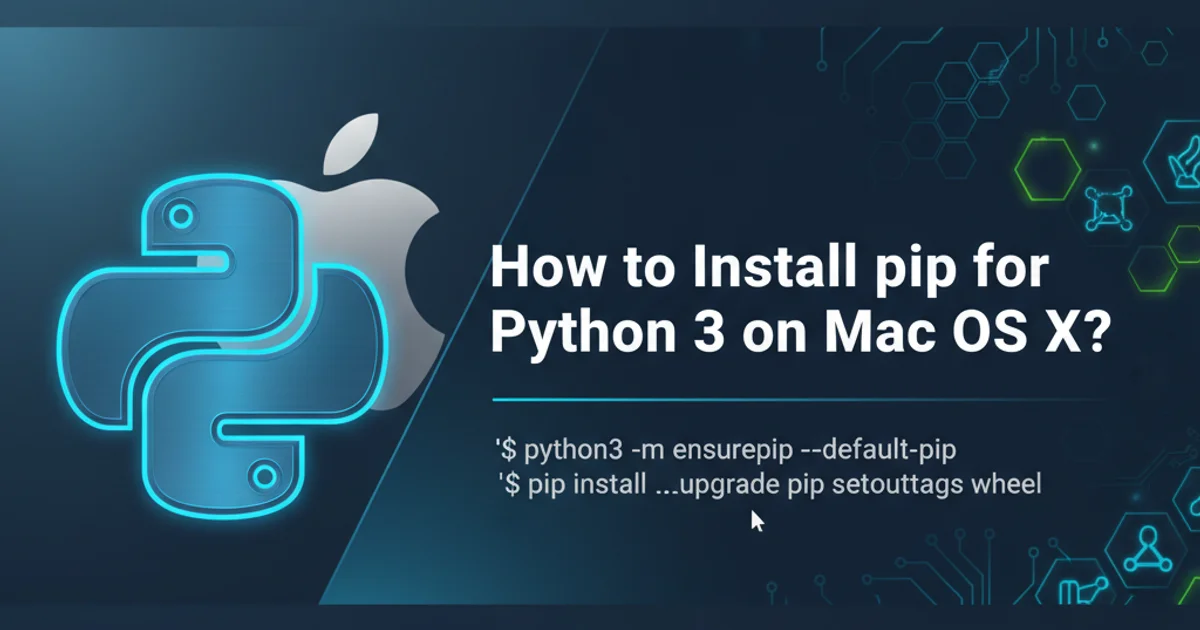How to install pip for Python 3 on Mac OS X?
Categories:
Installing Pip for Python 3 on macOS

A comprehensive guide to installing and verifying pip for Python 3.x environments on macOS, ensuring you can manage your Python packages effectively.
Pip is the standard package manager for Python. It allows you to install and manage additional packages that are not part of the Python standard library. For Python 3 on macOS, pip is often included with the Python installation. However, there are scenarios where you might need to install it manually or ensure it's correctly configured. This article will guide you through the process, focusing on Python 3.3 and later versions.
Understanding Python 3 and Pip on macOS
Modern macOS versions come with Python pre-installed, but this is typically an older Python 2.x version. For development, it's highly recommended to install Python 3.x separately. When you install Python 3 from the official Python website or using a package manager like Homebrew, pip for Python 3 (often referred to as pip3) is usually installed automatically alongside it. It's crucial to distinguish between pip (which might point to Python 2's pip) and pip3 (for Python 3).
flowchart TD
A[Start] --> B{Python 3 Installed?}
B -- Yes --> C{Pip3 Available?}
B -- No --> D[Install Python 3 (Homebrew/Official Installer)]
D --> C
C -- Yes --> E[Verify Pip3 Installation]
C -- No --> F[Install Pip3 via get-pip.py]
F --> E
E --> G[Use Pip3 to Install Packages]
G --> H[End]Flowchart for installing and verifying pip3 on macOS.
Verifying Existing Pip3 Installation
Before attempting a fresh installation, it's good practice to check if pip3 is already available and correctly configured on your system. Open your terminal and run the following commands to check for Python 3 and pip3 versions.
python3 --version
pip3 --version
Checking Python 3 and Pip 3 versions.
If both commands return version numbers (e.g., Python 3.x.x and pip x.x.x from /path/to/python3/site-packages), then pip3 is likely installed and ready to use. If python3 --version fails, you need to install Python 3 first. If pip3 --version fails, you'll need to install pip3.
python3 -m pip is generally a more robust way to invoke pip for Python 3, as it explicitly ties pip to the Python 3 interpreter you are using, avoiding potential conflicts with Python 2's pip.Installing Python 3 and Pip3 via Homebrew (Recommended)
Homebrew is a popular package manager for macOS that simplifies the installation of software. If you don't have Python 3 or pip3, Homebrew is the easiest way to get both. First, ensure Homebrew is installed. If not, you can install it by running the command from its official website.
1. Install Homebrew (if not already installed)
Open Terminal and paste the following command:
/bin/bash -c "$(curl -fsSL https://raw.githubusercontent.com/Homebrew/install/HEAD/install.sh)"
2. Install Python 3 using Homebrew
Once Homebrew is installed, run:
brew install python
This command installs the latest stable version of Python 3, which includes pip3.
3. Verify the installation
After installation, verify Python 3 and pip3:
python3 --version
pip3 --version
Homebrew typically symlinks python3 and pip3 into your PATH.
Manual Installation of Pip3 (if Homebrew is not an option)
If you've installed Python 3 manually (e.g., from python.org) and pip3 is missing, you can install it using the get-pip.py script. This method is generally only needed if pip3 wasn't bundled with your Python 3 installation.
1. Download get-pip.py
Download the get-pip.py script from the official pip documentation:
curl https://bootstrap.pypa.io/get-pip.py -o get-pip.py
2. Run the script with Python 3
Execute the script using your Python 3 interpreter. This ensures pip is installed for Python 3:
python3 get-pip.py
3. Verify the installation
Check if pip3 is now available:
pip3 --version
If successful, you should see the pip version for Python 3.
4. Remove the script (optional)
You can remove the get-pip.py file after successful installation:
rm get-pip.py
sudo pip install or sudo pip3 install unless absolutely necessary. Installing packages globally with sudo can lead to permission issues and interfere with system-managed Python packages. Prefer using virtual environments for project-specific dependencies.Using Pip3 to Install Python Packages
Once pip3 is installed and verified, you can use it to install any Python package available on PyPI (Python Package Index). The basic syntax is straightforward.
pip3 install <package-name>
pip3 install requests
pip3 install numpy==1.20.0
Examples of installing Python packages using pip3.
To upgrade an existing package, use the --upgrade flag:
pip3 install --upgrade <package-name>
To uninstall a package:
pip3 uninstall <package-name>